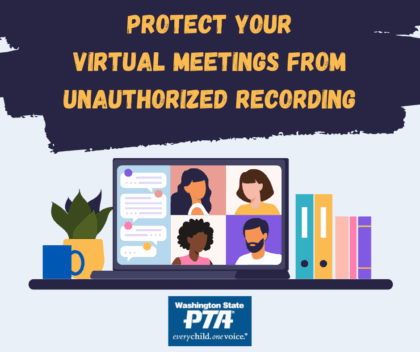 There is an increasing occurrence of virtual meetings being recorded and posted without consent or knowledge of PTAs. We hope this blog can provide some guidance on steps your PTA can take to try to protect itself from unauthorized recordings.
There is an increasing occurrence of virtual meetings being recorded and posted without consent or knowledge of PTAs. We hope this blog can provide some guidance on steps your PTA can take to try to protect itself from unauthorized recordings.
Be Careful of AI Meeting Assistants
Many AI meeting assistants (such as Otter.ai, Fireflies.ai, Fathom, Rewatch, Read.ai, etc.) join meetings as participants, appearing in the attendee list with names like “OtterPilot for Jane Doe” or “Fireflies Notetaker.” They typically join via a meeting link or calendar integration on behalf of a legitimate meeting participant.
Some of these bots can record audio and video and generate transcripts, even if your virtual meeting application’s internal recording feature is disabled. Depending on the bot’s settings, these recordings may be stored in the cloud and could inadvertently be shared on dashboards, team accounts, or made public via websites.
Before the Meeting
- Refer participants to your PTA policy stating that recording or transcribing meetings is not allowed. Reinforce this message in the “call to meeting” communications and start each meeting with an on-screen slide or by making a clear statement about the restrictions.
- Be sure to require registration for your meeting and request names and email addresses to discourage anonymous users. Review the registrants for any mismatched company names or domains. Look for addresses like @otter.ai, @fireflies.ai, @read.ai, or @fathom.video.
- Update the meeting settings so that participants are not allowed to join the meeting before the host.
- Verify that the setting that allows hosts to give participants permission to record locally is disabled.
- Utilize a “Waiting Room” to admit only attendees who you recognize or who are on your registration list.
During the Meeting
- Actively monitor the participant list for unusual names or silent joiners without video. Remove any participants with names that include “AI,” “Notetaker,” “Bot,” or any unfamiliar company name.
- Make sure you understand and can utilize your virtual meeting application’s security options to suspend participant activities, remove participants, or report suspicious behavior.
- If a participant requests to record, the host can choose not to grant recording access.
After the Meeting
- Some virtual meeting applications allow you to review an attendance report of your meeting which you can use to identify any unknown attendees or bots that might have joined briefly.
- If you discover a recording of your meeting online:
- Document where the meeting is posted (URL, date discovered).
- Contact the individual or company and request removal or report the content to the hosting platform (e.g., YouTube, Facebook).
For a refresher on why it’s not a great idea to have recordings of your PTA meetings floating around the internet, please check out this past blog from 2021 that is still relevant today, “7 Things You Need to Know About Recording and Live-streaming”.